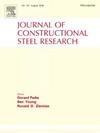混凝土填充冷成型斜槽 PEC 存根柱的轴向抗压行为和承载力预测
IF 4
2区 工程技术
Q1 CONSTRUCTION & BUILDING TECHNOLOGY
引用次数: 0
摘要
通过在由冷弯槽钢(CLC)和外部压条围成的空腔中填充混凝土,可以大大提高薄壁钢柱的稳定性和承载能力。然而,目前可获得的实验数据有限,尤其是关于混凝土填充 CLC 部分包裹复合材料 (PEC) 柱的轴向压缩行为的数据。本文旨在研究 CLC-PEC 短柱的抗压行为,并提出了预测柱轴向承载力的分析模型。研究通过对 12 个短柱试样进行轴向压缩试验,探讨了横截面尺寸和外部压缝板配置对 CLC-PEC 柱抗压性能的影响。结果表明,试件的破坏模式包括柱子下部外露侧的局部混凝土剥落,以及冷弯钢支撑槽的象脚形屈曲。通过对屈曲位置进行圆周切割,获得了受限混凝土的损伤面。研究结果表明,CLC 截面的特性对破坏面上的无效约束区有很大影响,哑铃形的有效约束区显示了高约束区的存在。在校准破坏面的基础上,对混凝土核心部位的轴向应力分布进行了基于数值模型的研究,以估算柱子在峰值荷载下的约束效应。该研究基于 143 个 CLC-PEC 柱的有限元分析 (FEA) 结果,采用多元回归分析来量化约束区与混凝土核心的面积比。根据测试结果对所提出的模型进行了评估,发现该模型比基于叠加强度法的轴向压缩荷载更可靠。建议的短柱轴向承载力考虑了每个构件的细长比。本文章由计算机程序翻译,如有差异,请以英文原文为准。
Axial compressive behavior and capacity prediction of concrete-filled cold-formed lipped channel PEC stub columns
The stability and capacity of thin-walled steel columns can be considerably upgraded by filling concrete into hollow spaces surrounded by cold-formed lipped channel (CLC) and external battens. However, there is limited experimental data available, especially for the axial compression behavior of concrete-filled CLC partially encased composite (PEC) columns. This paper aims to investigate the compressive behavior of CLC-PEC short columns and presents an analytical model for predicting the axial capacity of the column. The study explores the influences of cross-sectional dimensions and external batten plate configurations on the compressive performance of CLC-PEC columns through axial compression tests conducted on 12 short column specimens. The results indicate that the failure modes of the specimens involve localized concrete spalling on the exposed side at the lower part of the column, along with a elephant foot-shaped buckling of the cold-formed steel lipped channel. The damage surface of the confined concrete was obtained by circumferential cutting of the buckling location. The findings highlight the significant influence of the character of the CLC section on the ineffectively confined area at the failure surface, with a dumbbell-shaped effective confinement zone revealing the presence of a highly confined area. Based on the calibrated failure surfaces, a numerical model-based study of the axial stress distribution in the concrete core was then carried out to estimate the confinement effect of the columns under peak loading. The study employed multiple regression analysis to quantify the area ratio of the confined zone to the concrete core based on finite element analysis (FEA) results from 143 CLC-PEC columns. The proposed model was evaluated against test results and found to be more reliable than axial compression loads based on the superposition strength method. The proposed axial capacity of short columns takes into account the slenderness ratio of each member.
求助全文
通过发布文献求助,成功后即可免费获取论文全文。
去求助
来源期刊

Journal of Constructional Steel Research
工程技术-工程:土木
CiteScore
7.90
自引率
19.50%
发文量
550
审稿时长
46 days
期刊介绍:
The Journal of Constructional Steel Research provides an international forum for the presentation and discussion of the latest developments in structural steel research and their applications. It is aimed not only at researchers but also at those likely to be most affected by research results, i.e. designers and fabricators. Original papers of a high standard dealing with all aspects of steel research including theoretical and experimental research on elements, assemblages, connection and material properties are considered for publication.
 求助内容:
求助内容: 应助结果提醒方式:
应助结果提醒方式:


